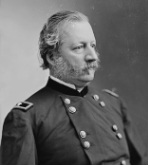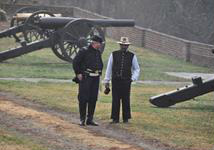Army Surgeon General Joseph K. Barnes
|
Timon Linn portrays Army Physician Joseph Barnes on assignment from the Surgeon General's office inspecting the sanitary conditions at Army of the Potomac field hospitals. In addition to inspection duties he explains his assignment of collecting specimens for the newly established Army Medical Museum, a center for research in military medicine and surgery.
|
Army Physician Joseph K. BarnesIn May 1862, Barnes was ordered to report to the Surgeon General in Washington and was assigned as attending surgeon for the city. While on this duty he formed the acquaintance of U.S. Secretary of War Edwin M. Stanton, who quickly gained a highly favorable impression of him. In February 1863, he was appointed a medical inspector with the rank of Lieutenant Colonel, stationed in Washington. In August he was further advanced to the position of medical
inspector general with the grade of Colonel. It was but a few weeks after this advancement that difficulties between Stanton and Surgeon General Hammond culminated in the relief of the latter from his office. In September, Barnes was by a War Department special order "empowered to take charge of the bureau of the Medical Department of the army and to perform the duties of Surgeon General during the absence of that officer." In August 1864 he was advanced to the full position of Surgeon General, with the grade of Brigadier General and in March 1865 he received the brevet of major general for faithful and meritorious service during the war. (http://en.wikipedia.org/wiki/Joseph_Barnes) |
Army Medical MuseumIn 1862, Surgeon General William Hammond directed medical officers in the field to collect "specimens of morbid anatomy together with projectiles and foreign bodies removed" and to forward them to the newly founded museum for study. Medical officers visited mid-Atlantic battlefields and solicited contributions from doctors throughout the Union Army. During and after the war, Museum staff took pictures of wounded soldiers showing effects of gunshot wounds as well as results of amputations and other surgical procedures. The information collected was published between 1870 and 1883 as The Medical and Surgical History of the War of the Rebellion.
(http://en.wikipedia.org/wiki/National_Museum_of_Health_and_Medicine) |






